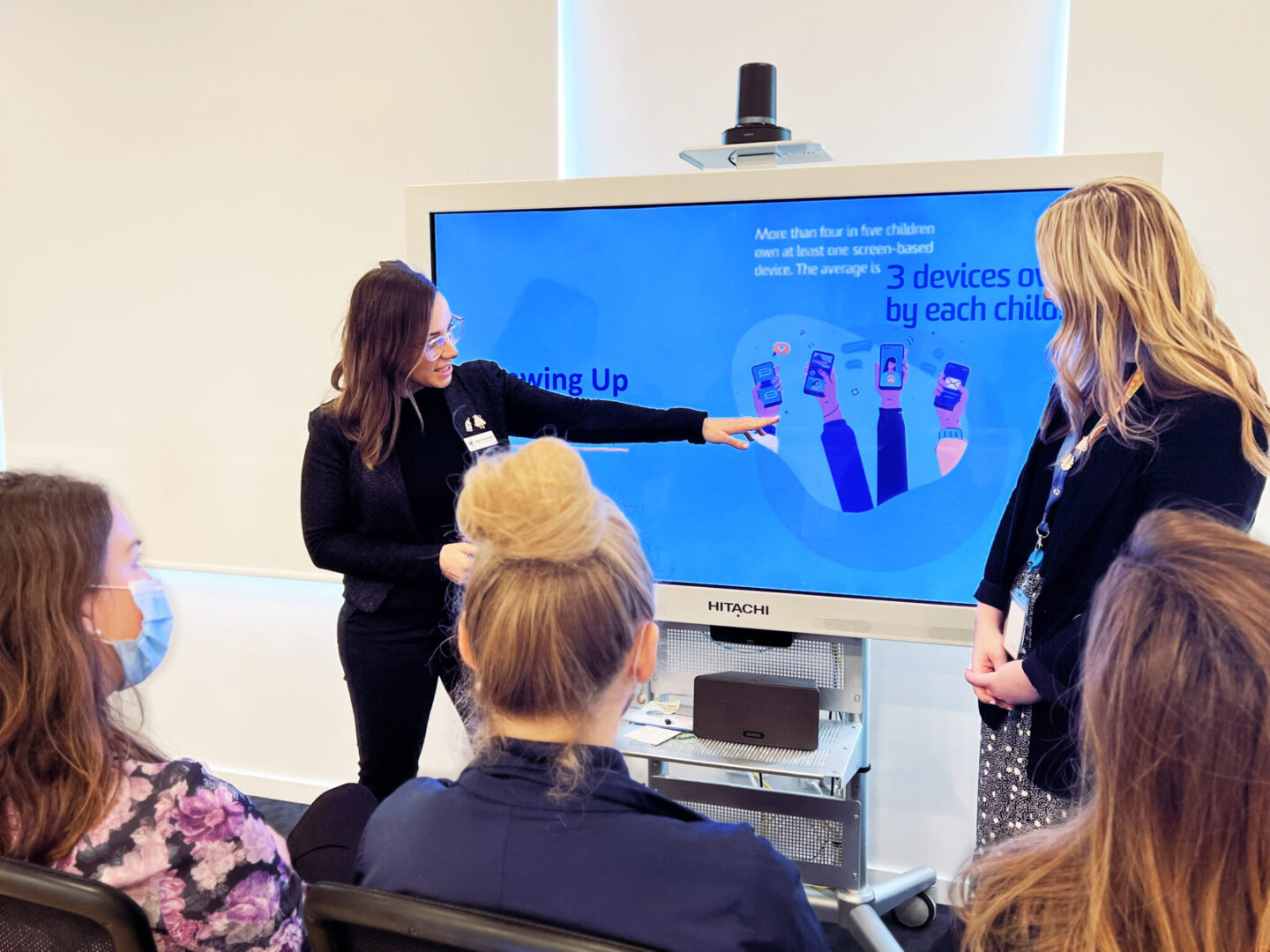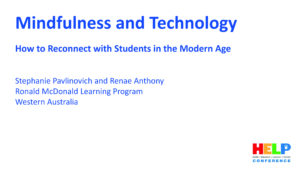
02 Aug Conference Presentation: Mindfulness and Technology: How to Reconnect with Students in the Modern Age
In the modern technology age that we exist, it is easy to lose track of the best and most beneficial ways to approach screen time for children. For students living with executive dysfunction as a result of their chronic illness, the line between what educates and what restricts through the use of technology, blurs even further.
This presentation aims to discuss link between chronic illness and executive functioning, the role technology plays and how we can utilise all the benefits of technology, particularly through mindfulness, to reconnect and reimagine the ways in which we can educate and support.
Download Presentation (PDF)
Presentation details:
- Presented at: RMHC H.E.L.P. Conference 2022
- Presentation: Mindfulness and Technology: How to Reconnect with Students in the Modern Age
- Presenters: Renae Anthony, Education Coordinator for the Ronald McDonald Learning Program in WA, and Stephanie Pavlinovich, Education Services Manager at Ronald McDonald House Charities Western Australia.
References
Ankucic, M., 2016. The Impact of Technology on Our Brain’s Ability to Learn – 3P Learning. [online] 3P Learning. Available at: https://www.3plearning.com/blog/impact-technology-brains-ability-learn [Accessed 28 July 2022].
Bergstrom, C., 2018. Mindfulness For Children — Gratitude Tree For Thanksgiving – Blissful Kids. [online] Blissful Kids. Available at: https://blissfulkids.com/playful-mindfulness-for-children-gratitude-tree [Accessed 28 July 2022].
Carter, T., 2021. Mindful Technology Use: The Next Digital Revolution. [online] ReadWrite. Available at: https://readwrite.com/mindful-technology-use-the-next-digital-revolution [Accessed 28 July 2022].
Dunckley, V., 2014. Gray Matters: Too Much Screen Time Damages the Brain. [online] Psychology Today. Available at: https://www.psychologytoday.com/us/blog/mental-wealth/201402/gray-matters-too-much-screen-time-damages-the-brain [Accessed 28 July 2022].
Firth, J., Torous, J., Stubbs, B., Firth, J., Steiner, G., Smith, L., Alvarez‐Jimenez, M., Gleeson, J., Vancampfort, D., Armitage, C. and Sarris, J., 2019. The “online brain”: how the Internet may be changing our cognition. World Psychiatry, 18(2), pp.119-129.
Gonski Institute for Education UNSW, 2021. Growing Up Digital Australia: Phase 2 technical report. Growing Up Digital Australia. [online] Sydney: Gonski Institute for Education. Available at: https://www.gie.unsw.edu.au/sites/default/files/documents/GONS5000%20Growing%20Up%20Digital%20Report_FINAL.pdf [Accessed 28 July 2022].
https://www.apa.org. 2019. Digital guidelines: Promoting healthy technology use for children. [online] Available at: https://www.apa.org/topics/social-media-internet/technology-use-children [Accessed 28 July 2022].
Institute For Healthy Living. 2016. Mindful Technology Use – Institute For Healthy Living. [online] Available at: https://institute4healthyliving.com/2016/04/20/mindful-technology-use/ [Accessed 28 July 2022].
Jargon, J., 2022. How to Overcome Multitasking Madness. [online] The Wall Street Journal. Available at: https://www.wsj.com/articles/how-to-overcome-multitasking-madness-11651272400 [Accessed 28 July 2022].
Kay, A. and Young, T., 2022. Distanced from Others, Connected to Self: Online Mindfulness Training Fosters Psychological Well-Being by Cultivating Authenticity. Academy of Management Learning & Education, 21(2), pp.261-281.
Li, C. and Lalani, F., 2020. The COVID-19 pandemic has changed education forever. This is how. [online] World Economic Forum. Available at: https://www.weforum.org/agenda/2020/04/coronavirus-education-global-covid19-online-digital-learning [Accessed 28 July 2022].
Qayumi, A., 2022. What is Mindful Technology?. [online] Ari Qayumi. Available at: https://ariqayumi.com/what-is-mindful-technology [Accessed 28 July 2022].
Ra, C., Cho, J., Stone, M., De La Cerda, J., Goldenson, N., Moroney, E., Tung, I., Lee, S. and Leventhal, A., 2018. Association of Digital Media Use With Subsequent Symptoms of Attention-Deficit/Hyperactivity Disorder Among Adolescents. JAMA, 320(3), p.255.
Ray, M., 2020. Translating Mindfulness to Distance Learning. [online] Edutopia. Available at: https://www.edutopia.org/article/translating-mindfulness-distance-learning [Accessed 28 July 2022].
Ruder, D., 2019. Screen Time and the Brain. [online] Hms.harvard.edu. Available at: https://hms.harvard.edu/news/screen-time-brain [Accessed 28 July 2022].
Skalická, V., Wold Hygen, B., Stenseng, F., Kårstad, S. and Wichstrøm, L., 2019. Screen time and the development of emotion understanding from age 4 to age 8: A community study. British Journal of Developmental Psychology, 37(3), pp.427-443.
Small, G., Lee, J., Kaufman, A., Jalil, J., Siddarth, P., Gaddipati, H., Moody, T. and Bookheimer, S., 2020. Brain health consequences of digital technology use. Dialogues in Clinical Neuroscience, 22(2), pp.179-187.
UNICEF DATA. 2022. COVID-19 and children – UNICEF DATA. [online] Available at: https://data.unicef.org/covid-19-and-children [Accessed 28 July 2022].
Whitford, E., 2018. In-class cellphone and laptop use lowers exam scores, a new study shows. [online] Insidehighered.com. Available at: https://www.insidehighered.com/news/2018/07/27/class-cellphone-and-laptop-use-lowers-exam-scores-new-study-shows [Accessed 28 July 2022].
wise minds. big hearts. 2022. Mindful Technology Use — wise minds. big hearts.. [online] Available at: http://www.wiseminds-bighearts.com/mindful-technology-use/ [Accessed 28 July 2022].
WRVO Public Media. 2022. Technology’s impact on childhood brain, language development. [online] Available at: https://www.wrvo.org/health/2019-12-21/technologys-impact-on-childhood-brain-language-development [Accessed 28 July 2022].
Small, G. W., Moody, T. D., Siddarth, P., & Bookheimer, S. Y. (2009). Your brain on Google: patterns of cerebral activation during internet searching. The American Journal of Geriatric Psychiatry, 17(2), 116-126.
Anderson, M., & Jiang, J. (2018). Teens, social media & technology 2018. Pew Research Center, 31(2018), 1673-1689.
Giedd, J. N. (2012). The digital revolution and adolescent brain evolution. Journal of adolescent health, 51(2), 101-105.
Yoo, H. J., Cho, S. C., Ha, J., Yune, S. K., Kim, S. J., Hwang, J., … & Lyoo, I. K. (2004). Attention deficit hyperactivity symptoms and internet addiction. Psychiatry and clinical neurosciences, 58(5), 487-494.
Panagiotidi, M., & Overton, P. (2018). The relationship between internet addiction, attention deficit hyperactivity symptoms and online activities in adults. Comprehensive psychiatry, 87, 7-11.



